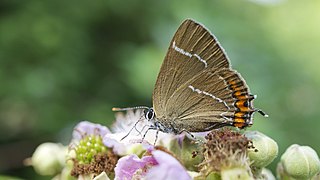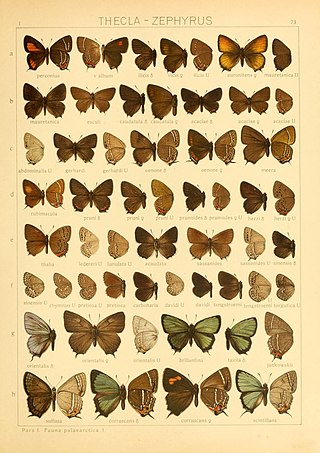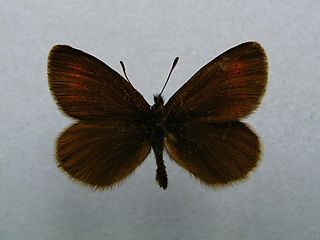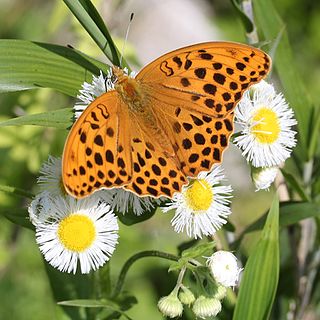
The brown hairstreak is a butterfly in the family Lycaenidae. The range includes most of the Palaearctic.

The white-letter hairstreak is a butterfly in the family Lycaenidae.

The black hairstreak is a butterfly in the family Lycaenidae.

The genus Satyrium contains butterflies in the family Lycaenidae. The species of this genus are found in the Holarctic ecozone. For distribution information see Further reading "Le genre Satyrium".

The purple-edged copper is a butterfly of the family Lycaenidae.

Satyrium esculi, the false ilex hairstreak, is a butterfly in the family Lycaenidae. The species was first described by Jacob Hübner in 1804.

Satyrium acaciae, the sloe hairstreak, is a butterfly in the family Lycaenidae.

Satyrium ledereri, the orange banded hairstreak, is a butterfly in the family Lycaenidae.

Scolitantides orion, the chequered blue, is a species of butterfly in the family Lycaenidae. It is found in Europe, Russia and east across the Palearctic to Japan.

The Eriphyle ringlet is a member of the subfamily Satyrinae of family Nymphalidae. It is a high mountain butterfly found in the Alps.Wheeler (1903) gives a short description

The white speck ringlet is a member of the subfamily Satyrinae of family Nymphalidae. It is a high-altitude butterfly found only in the Austrian Alps.

Polygonia egea, the southern comma, is a butterfly of the family Nymphalidae. It is found in southern Europe.

Agriades optilete, the cranberry blue, is a butterfly of the family Lycaenidae. It is found in north eastern Europe, the Alps, North Asia, Japan, Korea and north western North America.

Sinia is a genus of butterflies in the family Lycaenidae first described by Walter Forster in 1940. The species of this genus are found in the far eastern Palearctic realm.

Erebia pandrose, the dewy ringlet, is a member of the subfamily Satyrinae of the family Nymphalidae. It is found from the Arctic areas of northern Europe, the Pyrenees, Alps, the Apennine Mountains, the Carpathian Mountains, Kola Peninsula and Kanin Peninsula, part of the Ural and the Altai and Sayan Mountains up to Mongolia.

Satyrium prunoides is a butterfly of the family Lycaenidae. It was described by Otto Staudinger in 1887. It is found in the Russian Far East, Mongolia, north-eastern China and Korea.

Satyrium latior is a butterfly of the subfamily Lycaeninae. It was described by Johann Heinrich Fixsen in 1887. It is found in the Russian Far East, northern China and Korea.

Rapala arata is a small butterfly found in the East Palearctic that belongs to the lycaenids or blues family.

Argynnis anadyomene is a butterfly found in the East Palearctic that belongs to the browns family.

Satyrium eximius is a butterfly found in the East Palearctic that belongs to the blues family.

















